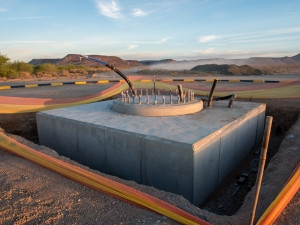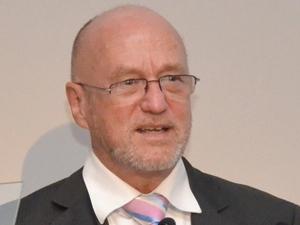
Foundations for the first phase of the multibillion-rand Square Kilometre Array (SKA) project are almost complete, as the 64th and final foundation for the MeerKat telescopes was poured today at the south site.
Close to 5 000 m3 of concrete and more than 570 tons of steel have been used to construct the foundations over the past nine months. MeerKat forms the first stage of the SKA, a project hosted by South Africa, eight African countries, Australia and New Zealand that aims to probe the mysteries of the universe.
The SKA will be a mega telescope, about 100 times more sensitive than the biggest existing radio telescope. The telescope array will comprise about 3 000 dish-shaped antennas and other hybrid receiving technologies, with a core of about 2 000 antennas and outlying stations of 30 to 40 antennas each, spiralling out of the core.
The SKA "will be one of a suite of new, large telescopes for the 21st century probing fundamental physics, the origin and evolution of the universe, the structure of the Milky Way Galaxy, the formation and distribution of planets, and astrobiology," it says.

Speaking at the site yesterday, science and technology minister Derek Hanekom said every time he visited the project, he was inspired by the rapid progress of infrastructure development and the expansion of the facilities, which made it clear SA would be able to handle the mega-infrastructure needs of the SKA.
Hanekom was speaking on the back of a visit to the SKA by a delegation of science and technology ministers and senior officials from Brazil, Russia, India, China and South Africa (BRICS).
The tour to the construction site was part of the first BRICS science, technology and innovation ministerial meeting, which started in Kleinmond on 9 February. Once completed, the SKA will collect data from deep space, which is expected to date back to the "Big Bang". The aperture arrays and dishes of the SKA are expected to produce 10 times the volume of current global Internet traffic.
The BRICS ministers and officials received a presentation on MeerKat and the SKA from Dr Bernie Fanaroff, director of the South African SKA Project (Saspo), after which they then toured the facilities, including MeerKat's predecessor KAT-7 and the underground data centre, which is still under construction.
Strict requirements
Tracy Cheetham, GM for infrastructure and site operations at Saspo, said the MeerKat foundations "were constructed to stringent specifications to ensure the antennae would be exceptionally stable.
"Even at wind gusts of up to 69km/h, scientists must be able to point the dishes at distant celestial objects in an exact manner, and the antennae must be able to survive wind speeds of up to 144km/h."
To meet these stability requirements, each foundation consists of eight steel-reinforced concrete piles at depths of between 5m and 10m, depending on the local soil conditions. A square slab of concrete (5.2m x 5.2m, and 1.25m thick) rests on top of the piles to add further stability. The 32 "holding down" bolts are pre-assembled in a circle to form a steel ring cage, or so-called "bird's nest", into which the concrete is cast.
All other MeerKat infrastructure should be complete by the end of March, the department says in a statement. "We are on the last leg now," said Cheetham, adding that finishing touches to the Karoo Array Processing Building (KAPB) and the power facility are under way.
The KAPB, a specialised underground bunker protected from radio frequency interference, will house all the data-processing racks and the power and backup equipment required for MeerKat.
The primary focus for the next two months will be on verifying that all infrastructure functions according to the required specifications. Testing involves cold and hot commissioning. Cheetham explains: "During cold commissioning, the power is connected without switching on the equipment. During hot commissioning, the machines are turned on and tested for a period of time."
Cheetham also said the ducting for the fibre-optic cable had been completed, so all that was left to do was for the contractor, Plessey, to pull the cable through and connect it.
Share